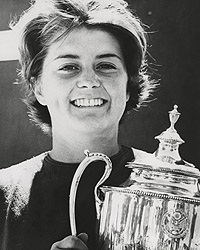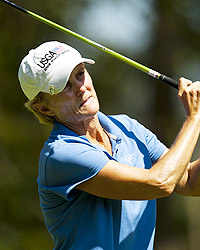There are many USGA champions at the 2012 USGA Senior Women’s Amateur Championship. Past U.S. Women’s Amateur champions, past U.S. Women’s Mid-Amateur champions and a number of past Senior Women’s Amateur champions. Two contestants, Marlene Stewart Streit and Carol Semple Thompson, are even in the World Golf Hall of Fame. A long time ago, Peggy (Margaret Harmon) Brady, another contestant in this championship, was the best player in the land.
Peggy was just 17. Granted, her place at the top was as the 1968 U.S. Girls’ Junior champion, but among the giggling girls in pork-pie hats and Peter Pan collars, Peggy was the best. In the Girls’ Junior final she defeated Kaye Beard, 3 and 2. In Peggy’s hometown of Shelbyville, Tenn., her victory was a very big deal.
 |
 |
|
| Peggy (Harmon) Brady after winning the 1968 U.S. Girls' Junior. | Peggy Brady competing in last year's Senior Women's Amateur |
This week, Brady is one of 132 players vying to win this national championship for female golfers age 50 and over. Brady is now 61 and in the intervening 44 years, nearly everything, of course, has changed.
At this year’s U.S. Girls’ Junior, some 100 college coaches milled around, looking for good college golf recruits. In 1968, no college golf coaches attended, perhaps because, in Peggy’s recollection, only three colleges awarded golf scholarships to women: Arizona State, which claimed The Great Gundy, JoAnne Gunderson, Odessa (Texas) Junior College, which had Kathy Whitworth, and Rollins College in Florida, which boasted Peggy Kirk Bell, Marlene Stewart Streit and Betty Probasco.
Women golfers of that era took the dearth of scholarships for granted. Title IX, which opened doors for so many young women, wasn’t enacted until 1972.
Not that Brady has any hard feelings. "I thought Title IX was great," she said. "What an opportunity for women! Finally, women could actually pursue avenues other than homemaking and secretarial work. I thought it was super that women could work at something like golf and actually get rewarded by getting scholarships."
Without the help of a scholarship, Brady, like many contestants here, mapped her own avenue to success. The youngster who whiled away hours at the 1968 Girls’ Junior looking up new words in the dictionary, enrolled at Vanderbilt University, just 50 miles from home.
Being a real girl chemist might be kind of cool, she told her fellow-competitors at the 1968 Girls’ Junior.
At Vanderbilt, Jess Neely, the university’s athletic director, offered to pay Brady’s expenses to the National Women’s Collegiate Championship. Off she went, as Vanderbilt’s lone entry, and was medalist. In 1971, Vanderbilt financed another try and in what was now a stroke-play championship, she finished third. She wanted to play again in 1972, but her first job offer offer in the computer industry interfered.
"My dad said I should report for work, so I did," Brady said. "I’ve since told my two kids if they have any other once-in-a-lifetime opportunities, don’t pass them up."
Peggy became a computer analyst. She and her husband Joe had two children and she encouraged their daughter Chris and son Scott to play golf. Chris got the break her mother never had. She won a full-ride golf scholarship to Vanderbilt and she and Peggy remain the only Vanderbilt mother and daughter to have both been named All-Americans. Scott recently received a mechanical engineering degree from Purdue.
After retiring from working for IBM and other companies, Peggy returned to competitive golf. This is her third USGA Senior Women’s Amateur since 2010.
Even as a youngster, Peggy was known for her head-down concentration and while she still has a bit of that, she has changed.
"As a junior you’re just kind of naïve and you’re in your own little space, plunking down the fairway and hitting shots," she said. "Unfortunately, we didn’t see those players often enough to be friendly with them. Your mission was to win. You didn’t have time to make friends."
If Brady is more laid-back in the arena she plays in today, it may be because of the arena.
"In the Women’s Senior, you’re much more aware of the game and your faults and things you should be doing right, like, you should have worked out more over the winter but you didn’t," she said.
Brady believes the Senior Women’s Amateur is a test of stamina when compared to other championships. To win the U.S. Women’s Open, for example, a player must prevail over four 18-hole rounds of golf. In the Senior Women’s Amateur, the winner survives two rounds of stroke-play qualifying and six rounds of match play. If Brady didn’t schedule as many work-out programs as she planned, it’s because her family, including her two-year-old grandson, Connor Wolfe, are her priority now.
"Working and raising a family were my primary objectives," she said. "You can always play golf. It’s certainly a lot less important, but this week, it’s great to be around professional women. We’re all moving through life together. Although some of the gals are a whole lot more focused, we’re all enjoying the time and space connection."
Last year, Brady advanced to the third round of match play. Perhaps this year will be better.
"My plan is just to play," she said, "just to try to hit good shots, try to make a good score on every hole and try to enjoy the surroundings and the people. You just say, ‘Well, I’m here and doing the best I can.’ We’re all just glad to be here."
Rhonda Glenn is a manager of communications for the USGA. Email her at rglenn@usga.org.
